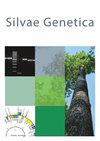Genomics studies for trait improvement in four important tree species: Current status and future prospects
IF 1
4区 农林科学
Q3 FORESTRY
引用次数: 0
Abstract
Abstract Trees hold the lifeline of the earth’s biodiversity and serve as a commercial entity delivering broad applications to human-kind. In addition to being used as wood and timber, trees are a source of secondary metabolites, medicinal compounds, and other derivatives with high commercial value. Thus, the scope for improvement of these traits and quality traits (insect/pest resistance, wood quality, etc.) has always been demanding; however, limited progress has been made compared to other crop species. Trait improvement has always been challenging in trees owing to several practical difficulties, but genomics has enabled the precise identification of genetic determinants of these traits and provided tools and approaches to tweak them for enhancing the traits of interest. Next-generation sequencing (NGS) has expedited genomics and transcriptomics research by facilitating the sequencing of genomes and transcriptomes, identifying genes, profiling the regulation of their expression, and constructing gene regulatory networks. Also, NGS has enabled the development of large-scale genome-wide molecular markers for high-throughput genotyping applications, which are useful in breeding for desirable traits. As it allows improved understanding of the gene function and its network at different developmental stages of trees with reference to an environmental stimulus can further help the breeder to enhance the knowledge on spanning genotype and phenotype. Thus, the potential of genomics in expediting trait improvement has been well realized; however, its application in tree species, particularly in commercially important ones including Tectona grandis, Azadirachta indica, Casuarina spp., and Salix spp, requires further research. Given this, the present review enumerates the progress made in genomics research on these four species and provides the roadmap for their trait improvement toward enhancing productivity and ecosystem services.四种重要树种性状改良的基因组学研究现状与展望
摘要树木是地球生物多样性的生命线,同时也是为人类提供广泛应用的商业实体。除了用作木材和木材外,树木还是次生代谢物、药用化合物和其他具有高商业价值的衍生物的来源。因此,这些性状和品质性状(抗虫性、木材品质等)的改进范围一直是苛刻的;然而,与其他作物品种相比,取得的进展有限。由于一些实际的困难,树木的性状改进一直是具有挑战性的,但是基因组学已经能够精确地识别这些性状的遗传决定因素,并提供工具和方法来调整它们以增强感兴趣的性状。新一代测序技术(NGS)通过促进基因组和转录组的测序、基因鉴定、表达调控分析和构建基因调控网络,加快了基因组学和转录组学的研究。此外,NGS还促进了大规模全基因组分子标记的开发,用于高通量基因分型应用,这对理想性状的育种非常有用。通过对环境刺激下树木不同发育阶段基因功能及其网络的了解,可以进一步帮助育种者提高对跨越基因型和表型的认识。因此,基因组学在加速性状改良方面的潜力已得到充分认识;然而,它在树种上的应用,特别是在具有重要商业价值的树种上,包括大构造、印楝、木麻黄和柳树,还需要进一步的研究。鉴于此,本文综述了这四个物种的基因组学研究进展,并提出了其性状改良的路线图,以提高其生产力和生态系统服务能力。
本文章由计算机程序翻译,如有差异,请以英文原文为准。
求助全文
约1分钟内获得全文
求助全文
来源期刊

Silvae Genetica
农林科学-林学
CiteScore
2.20
自引率
10.00%
发文量
10
审稿时长
3 months
期刊介绍:
Silvae Genetica is an international peer reviewed journal with more than 65 year tradition and experience in all fields of theoretical and applied Forest Genetics and Tree breeding. It continues "Zeitschrift für Forstgenetik und Forstpflanzenzüchtung" (Journal of Forest Genetics and Forest Tree Breeding) founded by W. LANGNER in 1951.
 求助内容:
求助内容: 应助结果提醒方式:
应助结果提醒方式:


